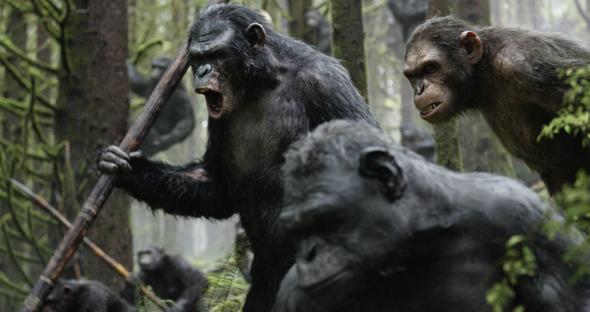When Rise of the Planet of the Apes came out in 2011, I pointed out (in “Caesar and the power of No“) that Caesar produced exactly two utterances in spoken English: a hoarse cry of “No,” and a single declarative clause at the end of the film, “Caesar is home.” Naturally, I went out to see the sequel, Dawn of the Planet of the Apes, to report on the way the franchise was developing its view of how apes evolve language.
And … forgive me if this seems pedantic, but the film is supposed to be science fiction, and I have to say that as far as linguistics is concerned, the science is crap.
I left the cinema half stunned by the visual effects (they are terrific—worth the price of admission), and half deafened by the soundtrack and Michael Giacchino’s bombastic score, but thoroughly disappointed at the inconsistent muddle of the way apes’ linguistic powers were portrayed.
What we see is a confused melange of half-hearted hand-sign language and occasional hoarsely croaked spoken sentences. Some of the time we were looking at subtitled sign-language conversations, though it is utterly unclear where the apes got the hang of sign language, since originally only one orangutan had been raised on sign. But at various dramatic points, when some ape was angry or wanted to say something to a human, vocalizations would mysteriously emerge. It was as if the filmmakers thought that at moments of drama we wouldn’t want to be bothered with subtitles.
Within the vocalized sentences, all sorts of things were inconsistent: Sometimes little words like is or the were omitted, giving the apes a kind of Tarzan-speak, but sometimes they were included, and occasionally an ape (not only Caesar) would apparently understand a sentence of considerable complexity and subtlety.
My theory of the theory that the screenwriters had concerning the apes’ command of language is that they had no theory. They vacillated between sign and English and Tarzanian at random.
I cannot judge the authenticity of the sign language shown (I would be very interested to hear the judgment of a fluent American Sign Language user on its authenticity), but to me it looked suspiciously terse to correspond to its elaborate propositions in the subtitles. And the spoken language vacillated between crude pidgin and occasional sophisticated grasp of English. Language seems not to have been a priority for the screenwriters (Mark Bomback, Rick Jaffa, and Amanda Silver).
The screen credits go on for about a quarter of an hour, listing whole cities of people employed doing the mocap and the explosions and the stunts and the CGI, but I don’t believe I saw a line in there for a linguistics adviser anywhere.
Perhaps we should not be surprised: As I have often noted before, when it comes to language, people just make stuff up.
A version of this post appeared on Language Log.
